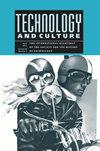封面文章:拉美人,宇宙的控制者
IF 0.7
3区 哲学
Q2 HISTORY & PHILOSOPHY OF SCIENCE
引用次数: 0
摘要
摘要:迭戈-里维拉(Diego Rivera)的壁画《宇宙的控制者》(El hombre controlador del universo,1934 年)可以被解读为预示着墨西哥核时代流行文化中对原子能的焦虑和乐观。里维拉的构想以史诗般的方式肯定了普通人在面对技术时代时的能动性,同时令人不安地预示了冷战的两极化,胡里安-索莱尔(Julián Soler)在其电影《Santo contra Blue Demon en la Atlantida》(1969 年)中重新审视了这些主题,该电影印证了里维拉壁画的预言。本文章由计算机程序翻译,如有差异,请以英文原文为准。
Cover Essay: La Gente, Controllers of the Universe
abstract:
Diego Rivera's mural El hombre controlador del universo (1934) can be read as foreshadowing the anxieties and optimisms about atomic power that shaped popular culture in Mexico during the nuclear age. In epic fashion, Rivera's vision affirms the agency of ordinary people in the face of a technological epoch while eerily anticipating the bipolarity of the Cold War, themes that would be revisited by Julián Soler in his film Santo contra Blue Demon en la Atlantida (1969), which bears out the prophecy of Rivera's mural.
求助全文
通过发布文献求助,成功后即可免费获取论文全文。
去求助
来源期刊

Technology and Culture
社会科学-科学史与科学哲学
CiteScore
0.60
自引率
14.30%
发文量
225
审稿时长
>12 weeks
期刊介绍:
Technology and Culture, the preeminent journal of the history of technology, draws on scholarship in diverse disciplines to publish insightful pieces intended for general readers as well as specialists. Subscribers include scientists, engineers, anthropologists, sociologists, economists, museum curators, archivists, scholars, librarians, educators, historians, and many others. In addition to scholarly essays, each issue features 30-40 book reviews and reviews of new museum exhibitions. To illuminate important debates and draw attention to specific topics, the journal occasionally publishes thematic issues. Technology and Culture is the official journal of the Society for the History of Technology (SHOT).
 求助内容:
求助内容: 应助结果提醒方式:
应助结果提醒方式:


